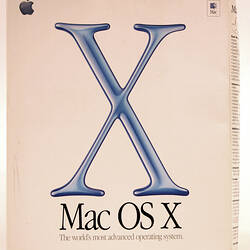Summary
Box, with two manuals and four CDs for the Macintosh operating system including an upgrade CD containing developers tools.
In 1999-2001, Apple discarded Mac OS 'Classic', the operating system it introduced in 1984 with the graphical user interface it had first introduced with the Lisa in 1983 and the Macintosh in 1984. It moved to a new operating system, Mac OS X, which was underpinned by an operating system called Nextstep, developed by Steve Jobs' company NeXT Computer during his absence from Apple. The Nextstep operating system was itself based on an operating system called UNIX. Versions of the Mac OS X operating system are named after big cats, the first of these being Cheetah.
Mac OS X (Cheetah) was first released as a server version in 1999, and in 2001 as a desktop oriented version.
Mac OS X (Cheetah):
1. Extended the legendary ease of use of Apple computers by implementing an improved graphical user interface.
2. Incorporated that revised GUI into a UNIX-based operating system.
3. By being UNIX-based, gave the OS for Macintosh computers increased stability and security.
4. Incorporated much of the Classic OS so as to achieve backward compatibility for the running of existing software.
5. Brought UNIX to personal computers.
As of 2009, Macintosh computers are the largest users of any of the operating systems based on the UNIX operating system.
The donor used this software as the operating system for his Macintosh computer in his legal practice.
Part of a representative collection of hardware, software, trade literature and promotional material that documents the history of the Apple company, and its contribution to, and impact on the computer industry and society.
Physical Description
Disk printed with white text on a grey background.
More Information
-
Collection Names
The Apple Company Collection, Internet Macintosh User Group (iMug) Collection
-
Collecting Areas
-
Acquisition Information
Donation
-
Manufacturer
Apple Computer Inc, Cupertino, California, United States of America, 2001
-
Inscriptions
Printed on disk, white text on grey: Mac OS X , A large "X" , the macintosh logo, the Apple, logo / "Developer Tools" Hand written text " 10.1" on the top right corner of each envelope, blue pen.
-
Brand Names
-
Classification
-
Category
-
Discipline
-
Type of item
-
Overall Dimensions
120 mm (Width)
-
Keywords



